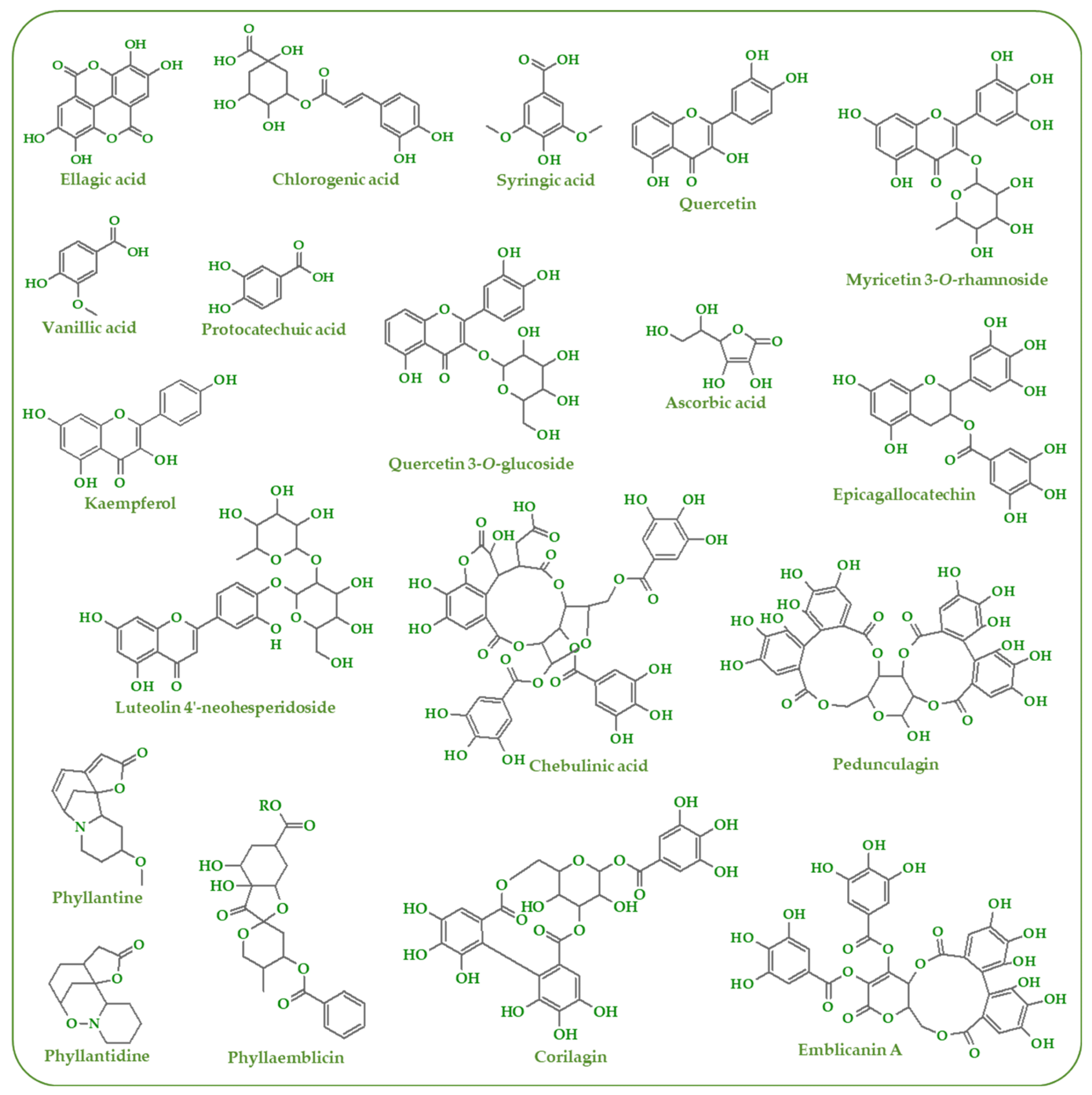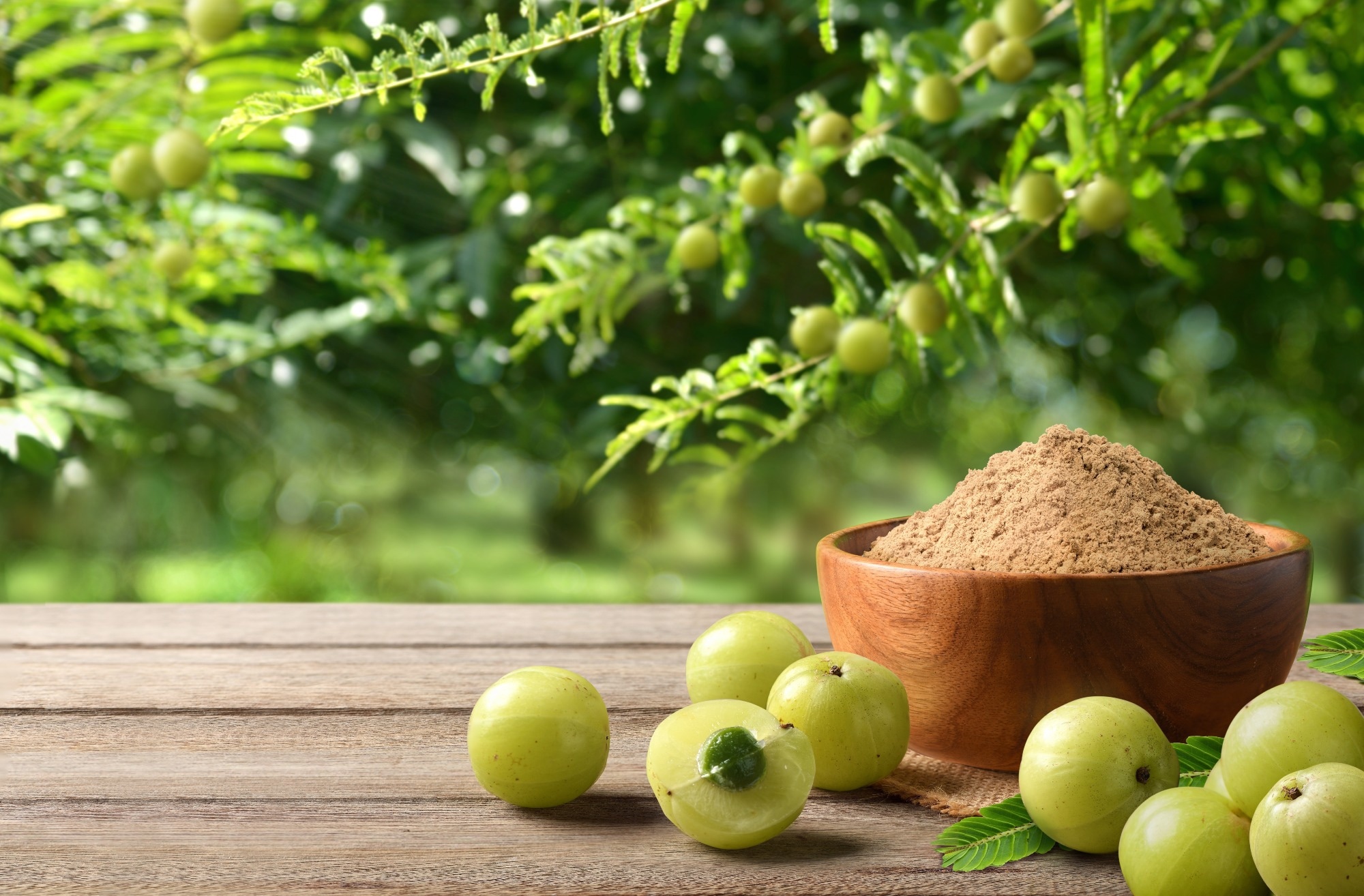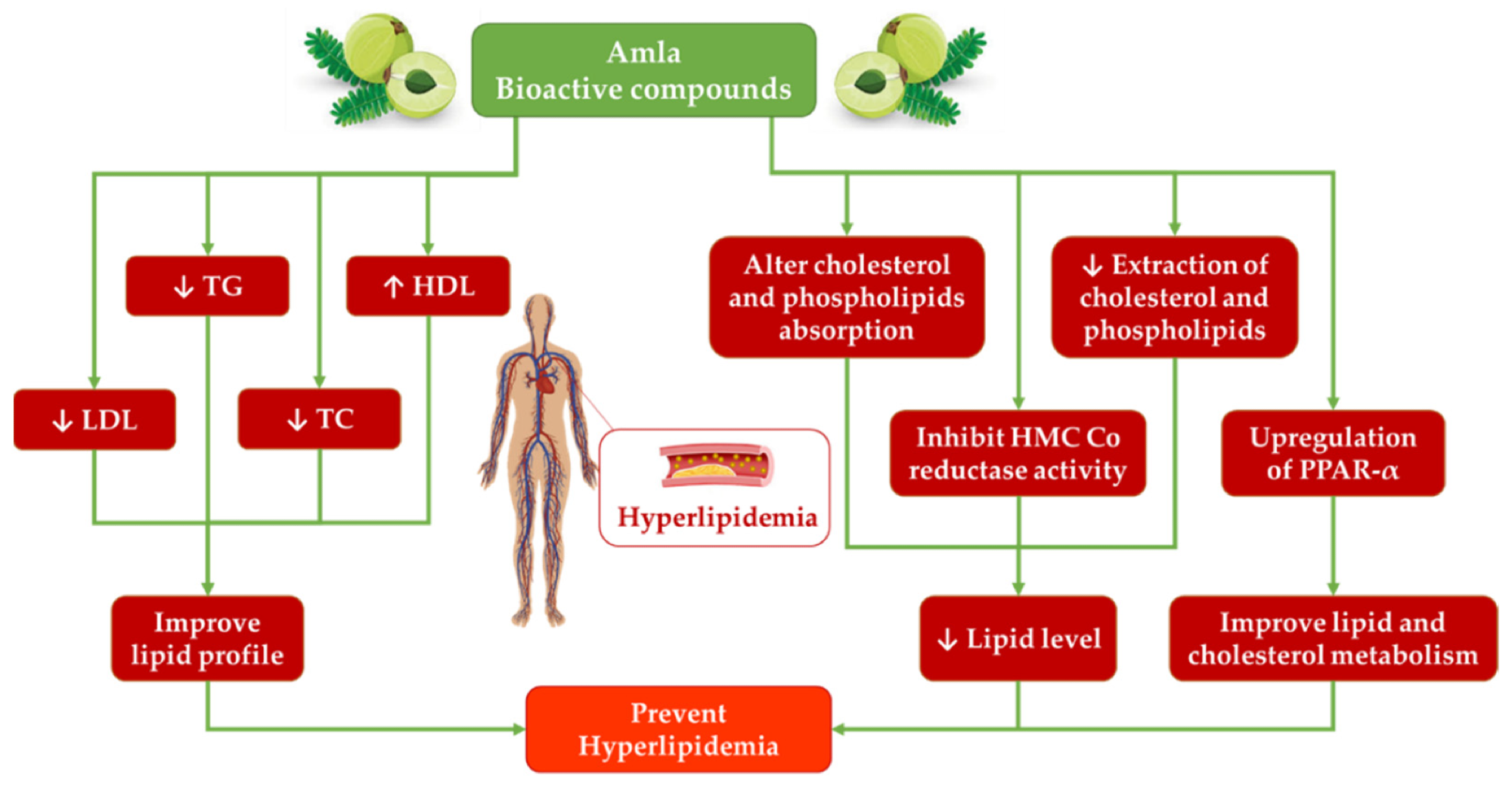Introduction
Nutritional and phytochemical profile
Antioxidant properties
Metabolic benefits
Other health benefits
Research and clinical evidence
References
Further reading
Amla is a vitamin-C–rich botanical whose polyphenols and tannins drive antioxidant, anti-inflammatory, and metabolic benefits. Human trials and mechanistic studies show improvements in lipids, glycemia, endothelial function, skin aging markers, and body composition.
 Image Credit: Sanit Fuangnakhon / Shutterstock.com
Image Credit: Sanit Fuangnakhon / Shutterstock.com
Introduction
As a key component of classic Ayurvedic formulations, such as chyawanprash and triphala, amla (Phyllanthus emblica L.), also known as Indian gooseberry, improves immunity, digestion, and metabolism while nourishing the skin, hair, and cardiovascular tissues.1,2 Rich in vitamin C, tannins, polyphenols, and essential minerals, amla exhibits powerful antioxidant, anti-inflammatory, and metabolic-regulating effects.
Amid growing global interest in plant-based therapeutics, amla is gaining recognition as a scientifically substantiated superfruit that bridges ancient Ayurvedic wisdom with modern evidence-based nutrition.1

Phytochemicals found in amla.1
Nutritional and phytochemical profile
Amla is considered one of the richest natural sources of vitamin C, as it contains 193–720 mg per 100 g of fresh fruit across cultivars, which significantly exceeds vitamin C levels in apples, limes, pomegranates, and grapes. Consequently, a 100 g serving (≈2–3 fruits) can meet or surpass the adult recommended dietary allowance of 75–90 mg/day.1,2,3
In addition to vitamin C, amla provides notable amounts of vitamins A, B1, and E, as well as minerals like calcium and iron, which contribute to its broad nutritional value.1,3 Amla fruit and other plant parts consist of phenolic acids like 4-hydroxybenzoic acid, gallic acid, coumaric acid, and protocatechuic acid, as well as flavonols such as kaempferol and quercetin.
Ellagitannins, such as emblicanin A and B, corilagin, chebulagic acid, chebulinic acid, geraniin, isocorilagin, pedunculagin, phyllanemblinins A-F, and punigluconin, are potent antioxidants that can also be found in amla fruit.1
Antioxidant properties
Bioactive compounds, such as vitamin C, polyphenols, and tannins, present in amla effectively neutralize reactive oxygen species (ROS), including superoxide anions, hydroxyl free radicals, nitric oxide (NO), and malondialdehyde (MDA). These constituents also support endogenous antioxidant defenses, including glutathione (GSH), catalase (CAT), glutathione peroxidase (GPx), and superoxide dismutase (SOD).1
In a rat model of Alzheimer’s disease, amla fruit powder (plain 500 mg/kg; fortified 300–500 mg/kg) reduced MDA levels while increasing both SOD and CAT activity, effects consistent with neuroprotection.4 Rodent models of chronic stress revealed that 50–100 mg/kg amla extract mitigated testicular oxidative damage, thereby improving testosterone levels and sperm quality.5
Human trials corroborate these findings, as individuals with metabolic syndrome consuming 250–500 mg of amla fruit extract twice daily for 12 weeks exhibited reduced lipid peroxidation and increased GSH levels.6
In individuals with a history of chronic smoking, two-month supplementation with 250 mg twice daily improved hemogram, lipid profile, antioxidant status, and pulmonary function, alongside improvements in cough with expectoration, exertional dyspnea, palpitations, sleep quality, irritability, and fatigue.7
The high vitamin C content in amla supports the synthesis of neurotransmitters like norepinephrine (via dopamine β-hydroxylase).3 Concordantly, amla tannoid fractions (≈100 mg/kg) improved learning and memory and reduced apoptotic markers in neurotoxicity models.8
 Image Credit: Photoonography / Shutterstock.com
Image Credit: Photoonography / Shutterstock.com
Amla exhibits strong anti-diabetic, lipid-lowering, and weight-regulating properties that have been supported by both preclinical and clinical studies. The high levels of soluble fiber, polyphenols, and ellagic acid in amla fruit contribute to improved glycemic control, lipid metabolism, and overall metabolic balance.6

Anti-hyperlipidemic role of amla.1
In diabetic animal models, amla extract at 250–500 mg/kg significantly reduced blood glucose levels while increasing serum insulin concentrations.9 In humans, 2–3 g/day of powdered fruit taken for 21 days lowered fasting and 2-h post-prandial glucose and improved lipid parameters.10 Separately, a β-glucogallin-standardized amla extract produced larger reductions in fasting and post-prandial glycemia and HbA1c than metformin (500 mg/day) in newly diagnosed type 2 diabetes with dyslipidemia.22
In patients with metabolic syndrome, 250–500 mg of aqueous amla extract twice daily for 12 weeks significantly lowered low-density lipoprotein (LDL), TC, TG, MDA, and C-reactive protein (CRP) while increasing high-density lipoprotein (HDL), NO, and GSH, improving lipid profile and limiting lipid peroxidation.6 Proposed mechanisms include downregulation of hepatic lipogenesis and upregulation of fatty-acid oxidation (e.g., adiponectin/PPAR-α signaling), with supportive preclinical data in NAFLD.17
In a clinical trial involving obese adults, 500 mg of amla extract, consumed twice daily for 90 days, significantly reduced visceral and subcutaneous fat, body mass index (BMI), and waist circumference measurements, while increasing skeletal muscle mass.13 Collectively, these findings demonstrate that amla intake supports glycemic balance, improves lipid metabolism, and promotes healthy body composition.
Health Benefits of Amla | Home Remedy for Immunity Booster | Amla Superfood l Gooseberry For health
Other health benefits
Rich in vitamin A, phenolic acids, and antioxidants, amla supports skin repair and protects against oxidative damage. To this end, a randomized, double-blinded, placebo-controlled trial found that topical application of a 0.1% amla branch gel for 84 days significantly improved skin hydration, elasticity, tone, and reduced wrinkles without irritation.14 In vitro, amla fruit formulations prevent damage from advanced glycation end products (AGEs) and ultraviolet (UV) radiation that contribute to intrinsic and extrinsic aging, respectively.15
Regarding hair health, amla components effectively increase the size of hair follicles and prolong the anagen phase of hair growth. Clinically, a higher anagen-to-telogen ratio and greater satisfaction in women with androgenetic alopecia have been reported after consuming amla syrup orally three times every day for 12 weeks.16
Preclinical data suggest that amla fruit mitigates fatty liver changes by enhancing adiponectin/PPAR-α signaling and suppressing lipogenic enzymes.17
Amla also demonstrates antiplatelet activity in patients with type 2 diabetes (reduced platelet aggregation; prolonged bleeding/clotting time); caution is advisable alongside aspirin or clopidogrel.19
Research and clinical evidence
An expanding body of well-designed clinical trials and systematic reviews supports the therapeutic potential of amla, particularly for metabolic, cardiovascular, and gastrointestinal health. For example, in a multicenter, randomized, double-blinded, and placebo-controlled trial involving 98 dyslipidemic patients, daily supplementation with 500 mg of amla extract twice daily for 12 weeks led to significant reductions in TC, TG, LDL, and the atherogenic index.20
In a comparative clinical study, amla demonstrated hypolipidemic effects comparable to simvastatin (20 mg/day) over six weeks in hyperlipidemic patients.21
Across randomized trials and meta-analyses, interventions of ~3–12 weeks consistently reduced fasting glucose, CRP, LDL-C, and total cholesterol, and increased HDL-C.23,24 However, effect sizes vary with dose, extract standardization, and study duration, underscoring the need for larger, longer, and more standardized trials.1,16
References
- Gul, M., Liu, Z., Haq, I., et al. (2022). Functional and Nutraceutical Significance of Amla (Phyllanthus emblica L.): A Review. Antioxidants, 11(5), 816. DOI:10.3390/antiox11050816, https://www.mdpi.com/2076-3921/11/5/816.
- Avinash, P. G., Hamid, Shams, R., et al. (2023). Recent Insights into the Morphological, Nutritional, and Phytochemical Properties of Indian Gooseberry (Phyllanthus emblica) for the Development of Functional Foods. Plants 13(5); 574. DOI:10.3390/plants13050574, https://www.mdpi.com/2223-7747/13/5/574.
- Vitamin C. Fact Sheet for health professionals, National Institutes of Health (NIH). https://ods.od.nih.gov/factsheets/VitaminC-HealthProfessional/, Accessed on 15 October 2025
- Vishala, T., Pitchaiah, G., Pravadha, D., & Annapurna, A. (2019). Effect of plain and fortified amla fruit powder on aluminum-induced Alzheimer’s Disease in Wistar Rats. Pharmacognosy Research 11(4);406-409. DOI:10.4103/pr.pr_17_17, https://www.phcogres.com/article/2019/11/4/104103prpr1717.
- Arun, S., Burawat, J., Yannasithinon, S., et al. (2018). Phyllanthus emblica leaf extract ameliorates testicular damage in rats with chronic stress. Journal of Zhejiang University - Science B 19; 948-959. DOI:10.1631/jzus.B1800362, https://link.springer.com/article/10.1631/jzus.B1800362.
- Usharani, P., Merugu, P. & Nutalapati, C. (2019). Evaluation of the effects of a standardized aqueous extract of Phyllanthus emblica fruits on endothelial dysfunction, oxidative stress, systemic inflammation, and lipid profile in subjects with metabolic syndrome: a randomised, double blind, placebo-controlled clinical study. BMC Complement Alternative Medicine 19, 97. DOI:10.1186/s12906-019-2509-5, https://bmccomplementmedtherapies.biomedcentral.com/articles/10.1186/s12906-019-2509-5.
- Biswas, T. K., Chakrabarti, S., Pandit, S., et al. (2014). Pilot study evaluating the use of Emblica officinalis standardized fruit extract in cardio-respiratory improvement and antioxidant status of volunteers with smoking history. Journal of Herbal Medicine 4(4); 188-194. DOI:10.1016/j.hermed.2014.09.002, https://www.sciencedirect.com/science/article/abs/pii/S2210803314000633.
- Justin Thenmozhi, A., Dhivyabharathi, M., Manivasagam, T., & Essa, M. M. (2016). Tannoid principles of Emblica officinalis attenuated aluminum chloride-induced apoptosis by suppressing oxidative stress and tau pathology via the Akt/GSK-3β signaling pathway. Journal of Ethnopharmacology 194; 20-29. DOI:10.1016/j.jep.2016.08.047, https://www.sciencedirect.com/science/article/abs/pii/S0378874116305736.
- Fatima, N., Hafizur, R.M., Hameed, A. et al. (2017). Ellagic acid in Emblica officinalis exerts anti-diabetic activity through the action on β-cells of the pancreas. European Journal of Nutrition 56; 591–601. DOI:10.1007/s00394-015-1103-y, https://link.springer.com/article/10.1007/s00394-015-1103-y.
- Akhtar, M. S., Ramzan, A., Ali, A., & Ahmad, M. (2011). Effect of Amla fruit (Emblica officinalis Gaertn.) on blood glucose and lipid profile of normal subjects and type 2 diabetic patients. International Journal of Food Sciences and Nutrition 62(6); 609-616. DOI:10.3109/09637486.2011.560565, https://www.tandfonline.com/doi/abs/10.3109/09637486.2011.560565.
- P, H. M., Ahn, S. A., Rousseau, M. F., et al. (2024). Potential synergistic antihyperglycemic effects of co-supplemental Amla and Olive extracts in hyperlipidemic adults with prediabetes and type 2 diabetes: Results from a real-life clinical study. Frontiers in Nutrition 11; 1462292. DOI:10.3389/fnut.2024.1462292, https://www.frontiersin.org/articles/10.3389/fnut.2024.1462292/full.
- Kanthe, P. S., Patil, B. S., Bagali, S. C., et al. (2017). Protective effects of ethanolic extract of Emblica officinalis (amla) on cardiovascular pathophysiology of rats, fed with a high-fat diet. Journal of Clinical and Diagnostic Research 11; CC05–CC09. DOI:10.7860/JCDR/2017/28474.10628, https://www.jcdr.net/article_fulltext.asp?id=10628.
- Rathore, R., Yadav, A., Khatkar, A., et al. (2025). Effect of Amla Extract on Body Mass Index, Waist Circumference, Total Body Fat, Visceral Fat, Skeletal Muscle Mass, Body Age, and Related Parameters: A Randomized, Open-Label Clinical Study in Obese Participants. Complementary Medicine Research. DOI:10.1159/000545247, https://karger.com/cmr/article-abstract/32/4/326/925955/Effect-of-Amla-Extract-on-Body-Mass-Index-Waist?redirectedFrom=fulltext.
- Chaikul, P., Kanlayavattanakul, M., Somkumnerd, J., & Lourith, N. (2021). Phyllanthus emblica L. (amla) branch: A safe and effective ingredient against skin aging. Journal of Traditional and Complementary Medicine 11(5);390-399. DOI:10.1016/j.jtcme.2021.02.004, https://www.sciencedirect.com/science/article/pii/S2225411021000134.
- Alsahli, M. A., Anwar, S., Alzahrani, F. M., et al. (2020). Health Promoting Effect of Phyllanthus emblica and Azadirachta indica against Advanced Glycation End Products Formation. Applied Sciences, 11(19), 8819. DOI:10.3390/app11198819, https://www.mdpi.com/2076-3417/11/19/8819.
- Akhbari, M., Firooz, A., Rahimi, R., et al. (2024). The effect of an oral product containing Amla fruit (Phyllanthus emblica L.) on female androgenetic alopecia: A randomized controlled trial. Journal of Ethnopharmacology 318; 116958. DOI:10.1016/j.jep.2023.116958, https://www.sciencedirect.com/science/article/abs/pii/S0378874123008267.
- Huang, C. Z., Tung, Y. T., Hsia, S. M., et al. (2017). The hepatoprotective effect of Phyllanthus emblica L. fruit on high-fat diet-induced non-alcoholic fatty liver disease (NAFLD) in SD rats. Food & Function 8; 842-850, DOI:10.1039/C6FO01585A, https://pubs.rsc.org/en/content/articlelanding/2017/fo/c6fo01585a.
- Kumari, P., Khatkar, B.S. & Duhan, A. (2019). Aonla phytochemicals: extraction, identification, and quantification. Journal of Food Science and Technology 56; 2278–2286. DOI:10.1007/s13197-019-03716-7, https://link.springer.com/article/10.1007/s13197-019-03716-7.
- Fatima, N., Pingali, U., & Muralidhar, N. (2014). Study of pharmacodynamic interaction of Phyllanthus emblica extract with clopidogrel and ecosprin in patients with type II diabetes mellitus. Phytomedicine 21(5); 579-585. DOI:10.1016/j.phymed.2013.10.024, https://www.sciencedirect.com/science/article/abs/pii/S0944711313004339.
- Upadya, H., Prabhu, S., Prasad, A. et al. (2019). A randomized, double blind, placebo-controlled, multicenter clinical trial to assess the efficacy and safety of Emblica officinalis extract in patients with dyslipidemia. BMC Complementary Alternative Medicine and Therapies 19, 27. DOI:10.1186/s12906-019-2430-y, https://bmccomplementmedtherapies.biomedcentral.com/articles/10.1186/s12906-019-2430-y.
- Gopa, B., Bhatt, J., & Hemavathi, K. G. (2012). A comparative clinical study of hypolipidemic efficacy of Amla (Emblica officinalis) with 3-hydroxy-3-methylglutaryl-coenzyme-A reductase inhibitor simvastatin. Indian Journal of Pharmacology 44(2); 238. DOI:10.4103/0253-7613.93857, https://journals.lww.com/iphr/fulltext/2012/44020/a_comparative_clinical_study_of_hypolipidemic.18.aspx.
- Majeed, M., Mundkur, L., Paulose, S., & Nagabhushanam, K. (2022). Novel Emblica officinalis extract containing β-glucogallin vs. metformin: a randomized, open-label, comparative efficacy study in newly diagnosed type 2 diabetes mellitus patients with dyslipidemia. Food and Function 13; 9523-9531. DOI:10.1039/D2FO01862D, https://pubs.rsc.org/en/content/articlelanding/2022/fo/d2fo01862d.
- Setayesh, L., Haghighat, N., Rasaei, N., et al. (2023). The impact of Emblica Officinalis (Amla) on lipid profile, glucose, and C-reactive protein: A systematic review and meta-analysis of randomized controlled trials. Diabetes & Metabolic Syndrome: Clinical Research & Reviews 17(3); 102729. DOI:10.1016/j.dsx.2023.102729, https://www.sciencedirect.com/science/article/abs/pii/S1871402123000255.
- Acampado, L. R. T., Chiu, H. H. C., Arcellana, A. E. S., & Añonuevo-Cruz, M. C. S. (2023). The Efficacy and Safety of Emblica officinalis Aqueous Fruit Extract among Adult Patients with Dyslipidemia: A Systematic Review and Meta-analysis. Acta Medica Philippina 57(5); 90. DOI:10.47895/amp.vi0.5047, https://actamedicaphilippina.upm.edu.ph/index.php/acta/article/view/5047.
Further Reading
Last Updated: Nov 3, 2025